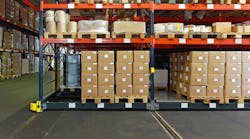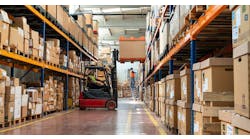Industry analyst firm Forrester has predicted that online sales will account for 17% of all U.S. retail sales by 2022, up from a projected 12.7% in 2017; this online sales rate is five times faster than the projected offline sales growth. With the explosion of e-commerce trade, warehouses are having a major capacity crunch. E-commerce orders are characterized by a low quantity of many items or just a singular item, whereas previously warehouses were organized to handle large volumes of each product, which were then shipped in bulk to brick-and-mortar stores around the country. In an e-commerce oriented warehouse, huge quantities of SKUs exist, each needing their own specific space or slot.
Warehouse managers know that inventory levels can fluctuate anytime within a year or sales season, especially during a holiday when inventory levels are typically at their peak, often double or triple normal levels. Plus, because of the Amazon-effect, consumers are demanding more products with faster and better service, putting additional strain on warehouse space. Because of this growth, many businesses are looking for additional space to distribute and store products, but warehouse real estate is hard to find. CNBC reports that the industrial vacancy rate is 5.3%—a 17-year low—and that e-commerce represents about 40% of the leasing of industrial properties today.
If acquiring additional warehouse space is out of the question, what is a retailer to do? The answer for additional space can be found within the four walls of your current operation. Following are some ways to maximize your storage capabilities.
Increase Storage Density
Pallet racks are material handling storage systems that store products that are on pallets, helping to increase storage density by using more vertical space instead of storing pallets on the ground. Pallet racking systems are most effective for storing large pallets of varying, medium-to-large goods. Modular pallet racks can scale to fit any warehouse configuration to minimize wasted space. Plus, pallet racks can be easily adjusted to product mix changes by simply reconfiguring the racks and using them with different products, saving money.
Avoid dead zones (unused pallet rack storage) in the pallet rack by using the entirety of the pallet rack depth. Instead of lining a shelf with one SKU and having workers reach deep into the rack to grab the next SKU, use a carton flow system to load all the SKUs behind each other and let them flow forward to the order pickers on the slanted shelving. This means more SKUs in less space. Not only will this help maximize space utilization in the warehouse or distribution center, it will help to make inventory easier to monitor and control while also reducing travel time and footpath between picks.
Improve Picking Operations
Order picking is the process of pulling items from inventory in the warehouse to fill a customer order. To take less space, use high-density pick modules—multi-level storage units made from a combination of mezzanines, conveyors, carton flow racks, pallet racks, static racks and other equipment that delivers goods to pickers at each level. By stacking the racks, less space on the floor is taken while pickers can take less time to pick orders from the rack of SKUs that are close by and easy to reach.
Multi-level pick modules use FIFO (first in, first out) stock rotation by using tilted shelves that use gravity flow to deliver containers of products or individual SKUs to the pick face. With FIFO, order pickers are presented with the product in the right order to be picked; this is particularly useful when items are stamped with an expiration date.
If using carton flow in picking operations, cartons can be replenished from the back of the shelving while picking goes on at the front. Pickers can pick from open boxes or individual items on shelves. Pallet flow systems allow the pallet to flow forward once the items on the pallet have been picked. Conveyors can tie everything together in the picking operation by bringing items to the picker or transporting empty cartons and pallets away so they can be recycled. Forklifts can help to eliminate double-handling by loading full pallets on the rack, without having to put each individual case on the rack. This combination of material handling solutions allows DCs to shave valuable seconds off of each order picked, keeps pedestrian and forklift traffic in separate aisles for improved safety, and allows distributors to accommodate the ever-increasing demand for faster fulfillment in e-commerce channels.
Avoid Dead Air Space with Right-Sized Containers
Make sure the warehouse space is consistent with items stored. A container of a particular size needs to be stored on a rack that accepts that size item, nothing less, in order to eliminate wasted space. If the container measures 2 ft. x 3 ft., then the rack should be approximately the same size. Containers need to fit products, too, so that the item stored fits snuggly within it to avoid storing dead air and to reduce wasted space inside of the containers.
Items within containers are often packaged with lightweight materials to protect the finished item. Packaging materials are typically chosen for their strength, weight and recyclability, but the packaging must be small enough to not take up too much space, but sufficient to protect the finished item. Packaging needs to be light also to keep shipping costs down. Using packaging that reduces the number of items that fit into a container affects space utilization and should be minimized.
Improve Product Flow
In the warehouse, products are constantly flowing in and out. Managing an efficient product flow improves turn-around times so that customer delivery levels can easily be met. The flow through the warehouse depends on the size of the facility, number of dock doors, products handled and labor pool.
Warehouses are often designed with either a U-shaped or L-shaped product flow. A U-shaped design arranges product flow around shipping and receiving areas, storing and/or processing orders in the middle, sharing both workers and material handling supplies. This also facilitates cross-docking, which leads to less product handling. The flow through the warehouse depends on the size of the facility, number of dock doors, products handled and labor pool.
The L-shaped design of product flow uses different parts of the warehouse for shipping and receiving. The advantage of this design is more storage space, larger sorting areas and bigger shipping/receiving areas that can handle more products.
Regardless of the design of your warehouse, speeding fulfillment leads to more available space in the warehouse. While picking orders, a smooth flow of products and orders needs to be kept so that workers aren’t idle or products/orders aren’t piling up waiting to be filled.
Slot and Re-Slot Inventory
Slotting improves storage density, opening up hidden storage space within a facility. Slotting maximizes warehouse space by improving storage by optimizing product location. Inventory is slotted using a variety of strategies focused on speed/velocity of products, item storage (carton, pallet, individual SKU), seasonal usage, etc. In a typical warehouse, approximately 80% of inventory is tied up in slow-moving items. Use high-density storage to minimize the footprint of slow-movers. Storing slow-movers in less space means more valuable space—such as the end caps and racks closest to the shipping or packing areas—is available for fast-moving products. Workers will be able to pick fast-moving products quicker and easier in this format, helping to minimize footsteps while maximizing pick speeds.
If products are picked down to the point where there are only a few remaining products, create smaller storage locations by re-slotting. This will free up valuable storage space. Slotting also removes obsolete inventory which takes up much needed space. Minimizing the amount of inventory carried in the warehouse keeps space in check.
Additional space can often be found within a warehouse without having to lease additional space. Look around the facility to uncover hidden space in unexpected places, such as over the dock doors, between existing pallet racks and overhead of the aisles. Aisle widths can be decreased potentially. Making these improvements will ensure enough space is available within the warehouse now and in the future.
Brian C. Neuwirth is vice president of sales and marketing at UNEX Manufacturing, Inc. (www.unex.com), a provider of order picking solutions.



